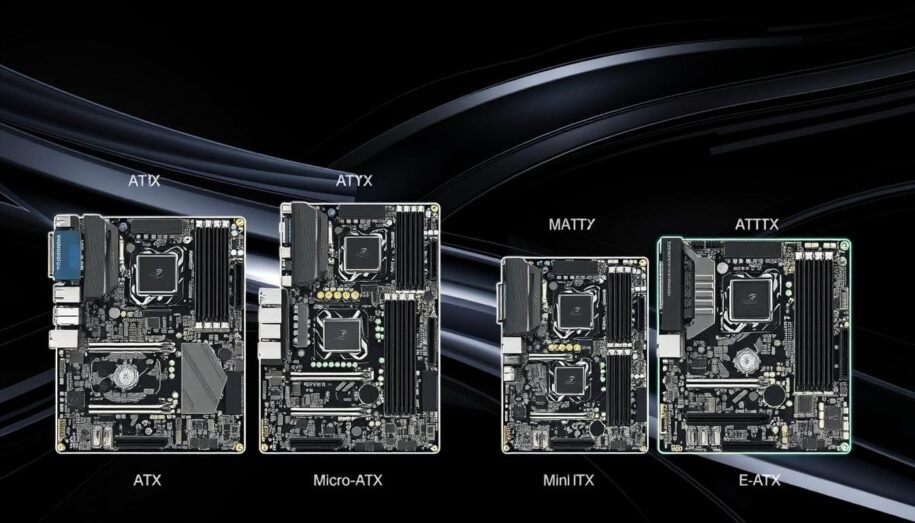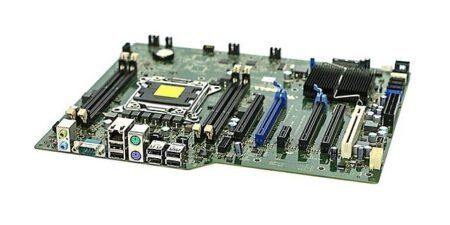
The motherboard is key to a computer’s performance and function. But, have you thought about the different sizes and how they affect your PC? Let’s dive into the world of motherboard sizes and shapes.

Key Takeaways
- Understand the various motherboard form factors, including ATX, MicroATX, Mini-ITX, BTX, NLX, WTX, MXM, and XTX.
- Discover how motherboard form factors influence your PC’s capabilities, such as expansion slots, cooling, and power requirements.
- Learn about the role of LGA socket types and their significance in the motherboard ecosystem.
- Gain insights into the benefits and applications of each motherboard form factor to make an informed decision for your next PC build.
- Explore the forgotten contenders and specialized options in the motherboard landscape.
What if the size of your motherboard could unlock hidden potential in your PC? Dive into our comprehensive guide to uncover the secrets of motherboard form factors and unlock the true power of your computing experience.
Introduction to Motherboard Form Factors
Building or upgrading a computer starts with choosing the right motherboard form factor. These are standardized sizes and layouts that fit with computer cases and power supplies. They make putting together a system easy and efficient.
The form factor you pick affects your computer’s size, features, and how well it works. It impacts performance, cooling, and looks. Knowing about motherboard form factors is key for anyone building or customizing a computer.
There’s a form factor for every need, from the small Mini-ITX to the large ATX. We’ll look into each one’s features, benefits, and uses. This will help you choose the best for your next computer project.
Understanding Motherboard Form Factors
Choosing the right motherboard form factor is key when building or upgrading a computer. The form factor decides the size, shape, and what the computer can do. It affects the features, how much you can add, and how it cools.
Why Form Factors Matter
Motherboard form factors are more than looks; they shape a computer’s function and compatibility. The form factor sets the motherboard’s size and layout. This, in turn, impacts the case, power supply, and other parts’ sizes and setups.
Factors Affecting Form Factor Selection
- Intended use: Different form factors fit specific needs, like gaming, workstations, or home theater PCs.
- Component compatibility: Some form factors work with certain CPUs, memory, and expansion slots. You must think about these when picking a motherboard.
- Space constraints: The case’s size can limit the motherboard’s size. This might mean choosing a smaller form factor.
- Cooling requirements: Bigger form factors often have better airflow and cooling. This is crucial for high-performance systems.
Knowing the differences between motherboard form factors, like ATX, microATX, and mini-ITX, is vital. It helps you make a choice that meets your needs and system requirements.
ATX: The Kingpin of Form Factors
For decades, the ATX (Advanced Technology Extended) motherboard has led the desktop computing world. It was introduced in the late 1990s and has since become the standard. It offers a great mix of size, features, and expansion options. This makes it perfect for many desktop systems, from basic workstations to top-notch gaming PCs.
The ATX form factor is known for its standard size, power supply spot, and layout. This design makes it easy for motherboards to work well with other computer parts. It’s great for both experts and DIY fans. Plus, its popularity means there are lots of compatible cases, coolers, and devices out there.
ATX motherboards are flexible, coming in sizes like full ATX, microATX, and mini-ITX. This variety meets different user needs. Whether you’re building a small office PC or a gaming beast, there’s an ATX option for you.
As the kingpin of motherboard form factors, ATX rules the desktop PC world. It’s reliable and supports many computing tasks. Its long-lasting popularity shows its well-designed and engineered nature, making it a favorite among system builders and enthusiasts.
MicroATX: Compact Yet Capable
In the world of motherboard form factors, MicroATX is a standout. It’s smaller than the popular ATX standard but still offers a lot. This makes MicroATX motherboards a great choice for many computing needs.
Benefits of MicroATX Boards
MicroATX motherboards may be small, but they’re mighty. They have several key benefits that make them appealing to builders and system integrators:
- Space-Saving Design: MicroATX boards are smaller than ATX, perfect for tight spaces. They’re great for small PCs and home entertainment systems.
- Ample Expansion Potential: Despite their size, MicroATX boards offer lots of room for expansion. They support many PCI, PCI Express, and memory slots, letting users customize their systems.
- Cost-Effective Solution: MicroATX motherboards are often cheaper than ATX. They’re a budget-friendly option without losing important features.
- Power-Efficient Performance: Many MicroATX boards use power-efficient components. This makes them ideal for low-power systems or those who care about energy use.
The versatility and space-saving benefits of microatx motherboards have made them a favorite. They’re chosen by system builders and enthusiasts who want compact, capable, and affordable motherboard form factors.
“The MicroATX form factor is the perfect balance of size, features, and value for many PC builds.”
Mini-ITX: The Ultimate in Small Form Factors
Mini-ITX is the smallest mainstream motherboard, perfect for ultra-compact systems. It focuses on efficiency and saving space, ideal for mini-PCs and home theaters. Size is key here.
Measuring 6.7 inches by 6.7 inches, Mini-ITX is tiny compared to ATX. Yet, it’s packed with the latest mini-itx processors and features. It’s a powerhouse in a small body.
Mini-ITX is also super energy-efficient. Its design uses less power, great for saving energy and keeping it quiet. This makes it perfect for those who care about the environment or want a quiet system.
While it lacks in expansion options, Mini-ITX makes up for it in size and versatility. It’s a favorite among DIY fans and those who want portable, discreet systems. Performance isn’t sacrificed for size.
In short, Mini-ITX is the top choice for small systems. It’s perfect for mini-PCs or home theaters. Its compact size and features make it a standout choice.
BTX: The Forgotten Contender
In the early 2000s, Intel introduced BTX (Balanced Technology Extended) as an alternative to traditional desktop PCs. This design aimed to solve thermal and power issues faced by ATX motherboards.
BTX improved airflow by placing the CPU near the back of the case. This allowed for better heat dissipation. It also standardized PSU placement for reliable power delivery.
Despite its advantages, BTX never gained widespread adoption. The shift from ATX was hard, and many were hesitant to adopt BTX. So, BTX faded into the background, overshadowed by ATX and its variants.
“The BTX form factor was an interesting attempt to address the thermal and power challenges of desktop PCs, but ultimately failed to gain traction in the market.”
Even though BTX is now forgotten, it played a role in the evolution of motherboard form factors. Its development and insights have helped improve modern desktop systems. They meet the growing demands of computing power and efficiency.
NLX: Designed for Low-Profile Systems
The NLX (New Low-profile Extension) motherboard form factor was made for compact computer systems. It’s different from ATX boards because it uses space better. This makes it great for small systems like office PCs and thin clients.
Applications of NLX Form Factor
The NLX form factor is perfect for many low-profile computing needs:
- Office Desktops: NLX motherboards fit well in office PCs. They save space without losing performance.
- Thin Clients: NLX is ideal for thin client systems. They are light, save energy, and fit in tight spaces.
- Embedded Systems: NLX boards are used in embedded computing. This includes industrial control systems and digital signage, where size and power matter.
- Media Center PCs: NLX boards are also great for media center PCs. They blend into entertainment setups without taking up much space.
Using the NLX form factor lets builders make nlx and motherboard form factors that are both small and powerful. They meet the needs of many low-profile computing tasks.
WTX: Workstation Powerhouse
The WTX (Workstation Technology Extended) is a top choice in motherboard form factors. It’s made for high-end workstations and servers. It offers unmatched performance and capabilities compared to desktops.
The WTX is bigger and has more features than standard ATX boards. It can handle multiple high-performance CPUs, lots of memory, and advanced expansions. This makes it perfect for tasks like 3D modeling, video editing, and scientific computing.
One big plus of the WTX motherboard is its support for various wtx and motherboard form factors. It’s great for workstation users. It has enhanced power delivery and advanced cooling solutions for demanding applications.
“The WTX motherboard is the ultimate workhorse, delivering the raw power and expandability that today’s power users demand.”
If you’re a content creator, data scientist, or IT admin, the WTX motherboard is a great choice. It meets your specific needs. As technology advances, the WTX remains a top pick for those who want the best from their workstations.
MXM: The Mobile Monster
In the world of motherboard form factors, MXM stands out as a game-changer for mobile devices. It’s a compact, modular design that has changed how laptops and mobile systems are built. This design offers flexibility and upgradability like never before.
MXM motherboards are made for mobile computing’s unique needs. They fit well in laptops, tablets, and other portable devices. Their design lets you easily upgrade or replace key parts, like the graphics processing unit (GPU).
One big plus of MXM is how it boosts mobile system performance. You can swap out the GPU to keep up with the latest graphics. This also applies to memory and storage, making MXM devices highly customizable and upgradable.
The MXM form factor is a favorite among laptop makers and fans. Its small size and modular design help create sleek, high-performance mobile devices. These devices can be easily updated to meet today’s computing needs.
In the world of mxm and motherboard form factors, MXM shows the creativity and innovation in mobile computing. It has changed how we use our portable devices. It’s leading the way to a future where performance and portability go hand in hand.

“The MXM form factor has revolutionized mobile computing, offering unparalleled flexibility and upgradability in a compact, space-efficient design.”
XTX: The Server Specialist
XTX motherboards are made for servers and big systems. They are bigger and stronger than usual desktop boards. This makes them perfect for powerful servers and data centers.
XTX boards are huge, at 12 inches by 13.6 inches. They have lots of room for many CPUs, lots of memory, and lots of ways to expand. This is great for servers that need lots of power and memory.
XTX boards can handle two top-notch server processors at once. This lets them do tough jobs like virtualization and high-performance computing easily.
| Feature | Benefit |
|---|---|
| Dual-socket support | Exceptional processing power for server and enterprise applications |
| Expansive memory capacity | Accommodates large amounts of RAM for memory-intensive workloads |
| Ample expansion slots | Enables the addition of specialized hardware like RAID controllers, network cards, and GPU accelerators |
XTX boards might not be as famous as desktop boards. But they are key for big computing jobs. As they keep getting better, they’ll help shape the future of computing.
Motherboard Form Factors
Motherboard form factors are the standard sizes and layouts of motherboards. They ensure that the motherboard fits well with computer cases and other parts. Knowing about these form factors is key when setting up or upgrading a computer.
These form factors are crucial for a computer’s design and function. They decide how much space is available and where components can go. This knowledge helps users choose the right parts for a smooth build.
Some common motherboard form factors include:
- ATX (Advanced Technology Extended): The most used form factor, known for its versatility and wide component support.
- MicroATX: A smaller version of ATX, perfect for those needing less space but still wanting compatibility.
- Mini-ITX: Very small, ideal for tiny systems like small form factor (SFF) setups.
- BTX (Balanced Technology Extended): Introduced by Intel, but not as popular.
- NLX (New Low-Profile Extension): Made for slim systems, like thin desktops.
- WTX (Workstation Technology Extended): Bigger, for high-end workstations and servers.
- MXM (Mobile PCI Express Module): For mobile devices, mainly laptops and notebooks.
- XTX (Extra Technology Extension): Focuses on servers, with more room for expansion and performance.
Each form factor has its own benefits and drawbacks, fitting different needs and preferences. It’s important to understand these to make the best choices for your computer setup.
LGA Socket Types and Their Role
Building a new computer or upgrading an old one requires matching the motherboard and CPU. This connection is made through the motherboard’s LGA (Land Grid Array) socket. Each LGA socket fits specific processor architectures, making the connection secure and reliable.
Common LGA Socket Types
Today’s motherboards often have these LGA socket types:
- LGA 1151: Works with Intel’s 6th, 7th, and 8th generation Core processors, plus Pentium and Celeron chips.
- LGA 1200: The newest Intel socket, supporting 10th and 11th generation Core processors.
- LGA 2066: For Intel’s high-end desktop (HEDT) CPUs, like Core i9 and Xeon W-series.
Choosing the right LGA socket type is key when picking a motherboard. It must match the lga socket types and motherboard form factors you need. This ensures a smooth and reliable computing experience.
| LGA Socket Type | Supported Processors | Motherboard Form Factors |
|---|---|---|
| LGA 1151 | Intel 6th, 7th, and 8th generation Core, Pentium, Celeron | ATX, Micro-ATX, Mini-ITX |
| LGA 1200 | Intel 10th and 11th generation Core | ATX, Micro-ATX, Mini-ITX |
| LGA 2066 | Intel Core i9, Xeon W-series | ATX, E-ATX |
Knowing about lga socket types and their motherboard form factors helps users make better choices. This ensures a smooth and reliable computing experience when building or upgrading a computer.

Conclusion
In the world of computer hardware, motherboard form factors are key. They define what a system can do and its limits. From the big ATX to the small Mini-ITX and special XTX, each has its own benefits and things to think about.
Knowing about motherboard form factors helps you choose the best one for your PC. Whether you need speed, small size, or special features, there’s a form factor for you. This variety lets you find the perfect fit for your needs.
The role of motherboard form factors will keep growing as technology advances. They are the base for new tech and solutions. By keeping up with changes, your computers will be ready for the future.
FAQ
What are the most common motherboard form factors?
Common motherboard types include ATX, MicroATX, Mini-ITX, BTX, NLX, WTX, MXM, and XTX. Each type has its own features. They are made for different computer systems.
What is the difference between ATX and MicroATX motherboards?
ATX is the most common motherboard. It balances size, features, and expansion well. MicroATX is smaller but still offers good features and options for compact systems.
What are the benefits of a Mini-ITX motherboard?
Mini-ITX is the smallest mainstream motherboard. It’s perfect for small systems. Mini-ITX focuses on efficiency and saving space, great for mini-PCs and home theaters.
What is the BTX form factor, and why did it not gain widespread adoption?
BTX was introduced by Intel in the early 2000s. It aimed to manage heat and power better. But, it didn’t catch on and is now mostly forgotten.
What is the purpose of the NLX form factor?
NLX is for low-profile systems like office PCs. It’s designed to save space. NLX motherboards are ideal for where size matters.
What is the WTX form factor used for?
WTX is for high-end workstations and servers. It’s larger and more feature-rich. WTX supports multiple CPUs, lots of memory, and advanced expansions for professional use.
What is the purpose of the MXM form factor?
MXM is for laptops and mobile devices. It’s compact and modular. MXM allows easy upgrades, like swapping out the GPU, to boost mobile system performance.
What is the XTX form factor used for?
XTX is for servers and enterprise systems. It’s designed for multiple CPUs, lots of memory, and extensive expansions. XTX is for demanding server and data center needs.
What are the common LGA socket types, and why are they important?
LGA sockets determine CPU and motherboard compatibility. Types like LGA 1151, LGA 1200, and LGA 2066 are common. Choosing the right LGA socket is key for CPU compatibility.






